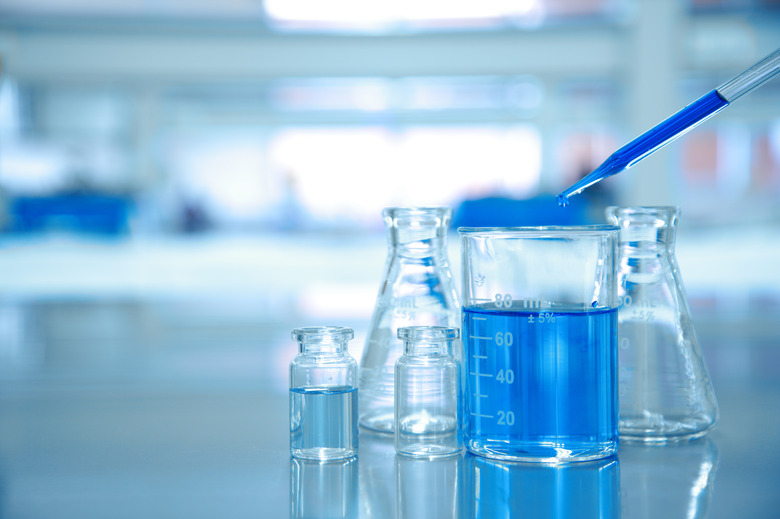The Types Of Bottles Used For Storing Acids & Bases
Strong acids and bases can pose a significant health risk. Because of this, safe handling is a major concern, and you should always store a chemical in the right container. Acids and bases each have unique properties, which means that some containers are suitable for acids but not bases, and vice versa.
TL;DR (Too Long; Didn't Read)
Bottles for storing acids and bases are typically made from glass, polymethylpentene, polyethylene or Teflon.
Glass Bottles
Glass Bottles
Glass bottles are ideal for storing most acids and bases. Ordinary glass is largely inert and does not react chemically with most substances, including aqueous substances like acids and bases. It is also nonporous, which means it will not absorb or contaminate chemicals. The major drawback of glass is the fact that it breaks easily and makes sharp, dangerous shards when broken. Not all substances are safe to store in glass; for example hydroflouric acid should not be stored in a glass container but can be stored in polymethylpentene, polyethylene or Teflon.
Polymethylpentene Bottles
Polymethylpentene Bottles
Polymethylpentene is a type of plastic. Like glass, this material is clear and highly resistant to corrosion, which makes it suitable for storing both acids and bases of different strengths. Polymethylpentene is often used to make beakers and graduated cylinders, which are both used during the experimental process, but is also suitable for storage purposes.
Polyethylene Bottles
Polyethylene Bottles
Polyethylene is another type of plastic. Like polymethylpentene and glass, it is compatible with both acids and bases of different strengths. This material is very strong and difficult to break, making it ideal for chemical storage, as breakages cause spills. Polyethylene is typically used to make waste bags, containers and pumps.
Teflon Bottles
Teflon Bottles
Teflon is best known for being slippery, as most substances are unable to stick to it. Teflon is also resistant to many chemicals, including sulfuric acid, sodium hydroxide and nitric acid, which are all very strong acids or bases. For this reason, Teflon-coated containers are ideal for storing many acids and bases.
Other Important Features
Other Important Features
While a bottle's material varies depending on what kind of acid or base it is designed to hold, some features are the same regardless of the chemical. All bottles designed to contain acids and bases should have tight-fitting caps; loose glass stoppers are not suitable for long-term storage. An exception is made for any acid or base mixture that produces gas, as gas buildup can destroy the container. In addition, a suitable container must be able to be clearly labeled.
Cite This Article
MLA
Leggett, Rochelle. "The Types Of Bottles Used For Storing Acids & Bases" sciencing.com, https://www.sciencing.com/types-used-storing-acids-bases-8456845/. 14 May 2018.
APA
Leggett, Rochelle. (2018, May 14). The Types Of Bottles Used For Storing Acids & Bases. sciencing.com. Retrieved from https://www.sciencing.com/types-used-storing-acids-bases-8456845/
Chicago
Leggett, Rochelle. The Types Of Bottles Used For Storing Acids & Bases last modified March 24, 2022. https://www.sciencing.com/types-used-storing-acids-bases-8456845/
